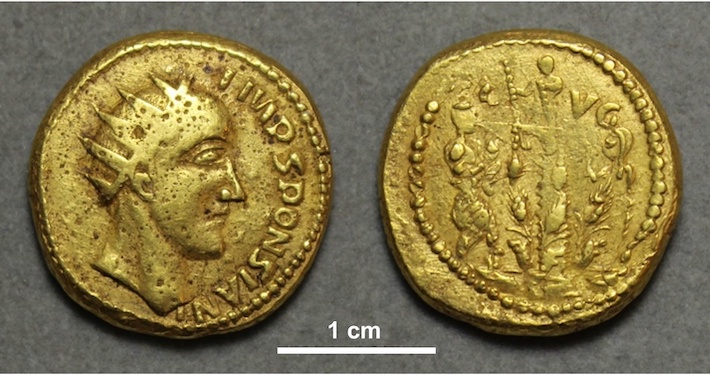 GLASGOW, SCOTLAND—A new study of ancient gold coins unearthed in Transylvania in 1713 suggests that the man shown on them may have ruled as an emperor of Rome, according to a report in Artnet News. Coins from the hoard are now held in the Hunterian Museum at the University of Glasgow and at Romania’s Brukenthal National Museum. When assessed in the mid-nineteenth century, the coins held in Scotland had been determined to be fakes, but the recent analysis suggests that their flaws reflect production by inexperienced minters living on the fringes of Roman society. The study also found that the coins had been in circulation, and that they had been buried for a long time. Analysis of the coins held in Romania reached the same conclusion. The image on the coins depicts a man named Sponsian, who in now thought to have been a military commander posted in Rome’s province of Dacia, which is now Romania. He may have taken on the role of emperor to establish order in the isolated territory. “For the history of Transylvania and Romania in particular, but also for the history of Europe in general, if these results are accepted by the scientific community, they will mean the addition of another important historical figure in our history,” concluded Alexander Constantin Chitută of the Brukenthal National Museum. Read the original scholarly article about this research in PLOS ONE. To read about a Roman coin featuring a short-lived ruler of a breakaway state known as the Gallic Empire, go to "Artifact."
GLASGOW, SCOTLAND—A new study of ancient gold coins unearthed in Transylvania in 1713 suggests that the man shown on them may have ruled as an emperor of Rome, according to a report in Artnet News. Coins from the hoard are now held in the Hunterian Museum at the University of Glasgow and at Romania’s Brukenthal National Museum. When assessed in the mid-nineteenth century, the coins held in Scotland had been determined to be fakes, but the recent analysis suggests that their flaws reflect production by inexperienced minters living on the fringes of Roman society. The study also found that the coins had been in circulation, and that they had been buried for a long time. Analysis of the coins held in Romania reached the same conclusion. The image on the coins depicts a man named Sponsian, who in now thought to have been a military commander posted in Rome’s province of Dacia, which is now Romania. He may have taken on the role of emperor to establish order in the isolated territory. “For the history of Transylvania and Romania in particular, but also for the history of Europe in general, if these results are accepted by the scientific community, they will mean the addition of another important historical figure in our history,” concluded Alexander Constantin Chitută of the Brukenthal National Museum. Read the original scholarly article about this research in PLOS ONE. To read about a Roman coin featuring a short-lived ruler of a breakaway state known as the Gallic Empire, go to "Artifact."
Coin Study Identifies Possible New Roman Emperor
